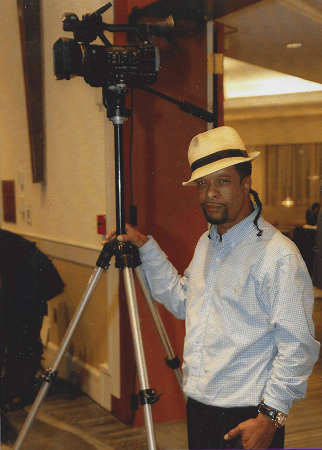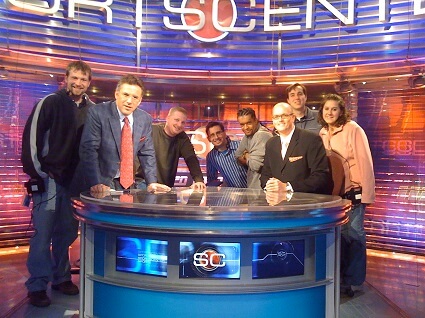Please fill out the following information, and RRFC Admissions will contact you to discuss our program offerings:
Issue #217 – Mentor News
by Liya Swift

Sean Taylor of Visual Jedi
 Regarding your time at ESPN, they say in order to work in sports broadcasting you’ve really got to be on your game because oftentimes it all comes down to the second.
“It’s very on the edge. [There are times when] you’ve got the talent showing up one minute before we go on air… and we’re trying to get the lighting on them and we’re trying to mic them up and we’re trying to set the camera focus on them and all of that stuff…
Another thing is just the overall amount of information in these producers. They’re obsessed. They want to bring in the latest information… when something in sports happens, these producers want to mix up the content…So people have got to scramble and rearrange the script, rearrange the teleprompter, rearrange the video that they talk to, within the commercial break, within seconds…
You’re pushing all these buttons and you’re hearing the speaker go to break, three, two, one, and break time. And at the break time we’re doing something called ‘fixes’ where, if we made a mistake on something we will re-voice it and redo it in the commercial break, then cue it back up again and get ready to go back on air again. It’s kind of an adrenaline rush.”
What’s your advice on how Film Connection students can make the most of the program while they’re in it?
“I would say to be a sponge, basically. Observe as much as you can and do as much hands-on as you can. Really, honestly, I would say take this opportunity to gain real-world experience while you can, because the real world is changing, and when these mentors are with you, they’re actually preparing you to take over or assist with the company.
That’s really what my main goal is when I’m with a mentee (extern), just trying to prepare them to eventually sit in my chair so I can walk away. That’s what I told a guy who said, ‘How do I know when I’m ready?’ I said, ‘When you can sit down in my chair and just edit a wedding from beginning to end. You can take out my camera, pop in an SD card, ingest it and edit it and know what you’re doing. And when the glitches happen, you can get over it and actually finish it…That’s how you know you’re ready.
Other than that, you can have as many pieces of paper as you want in your hand that say that you did this and that and helped out halfway with a project, but until you put some muscle into the game, and build your own confidence level and actually do it, none of that matters.”
Learn how Film Connection works.
Regarding your time at ESPN, they say in order to work in sports broadcasting you’ve really got to be on your game because oftentimes it all comes down to the second.
“It’s very on the edge. [There are times when] you’ve got the talent showing up one minute before we go on air… and we’re trying to get the lighting on them and we’re trying to mic them up and we’re trying to set the camera focus on them and all of that stuff…
Another thing is just the overall amount of information in these producers. They’re obsessed. They want to bring in the latest information… when something in sports happens, these producers want to mix up the content…So people have got to scramble and rearrange the script, rearrange the teleprompter, rearrange the video that they talk to, within the commercial break, within seconds…
You’re pushing all these buttons and you’re hearing the speaker go to break, three, two, one, and break time. And at the break time we’re doing something called ‘fixes’ where, if we made a mistake on something we will re-voice it and redo it in the commercial break, then cue it back up again and get ready to go back on air again. It’s kind of an adrenaline rush.”
What’s your advice on how Film Connection students can make the most of the program while they’re in it?
“I would say to be a sponge, basically. Observe as much as you can and do as much hands-on as you can. Really, honestly, I would say take this opportunity to gain real-world experience while you can, because the real world is changing, and when these mentors are with you, they’re actually preparing you to take over or assist with the company.
That’s really what my main goal is when I’m with a mentee (extern), just trying to prepare them to eventually sit in my chair so I can walk away. That’s what I told a guy who said, ‘How do I know when I’m ready?’ I said, ‘When you can sit down in my chair and just edit a wedding from beginning to end. You can take out my camera, pop in an SD card, ingest it and edit it and know what you’re doing. And when the glitches happen, you can get over it and actually finish it…That’s how you know you’re ready.
Other than that, you can have as many pieces of paper as you want in your hand that say that you did this and that and helped out halfway with a project, but until you put some muscle into the game, and build your own confidence level and actually do it, none of that matters.”
Learn how Film Connection works.
or call (800) 755-7597

RRFC is education upgraded for the 21st century.
Get the latest career advice, insider production tips, and more!
Please fill out the following information, and RRFC Admissions will contact you to discuss our program offerings:
Stay in the Loop: Subscribe for RRFC news & updates!
© 2025 Recording Radio Film Connection & CASA Schools. All Rights Reserved.
